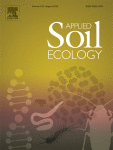Ver ítem
- xmlui.general.dspace_homeCentros e Institutos de InvestigaciónCIAP. Centro de Investigaciones AgropecuariasInstituto de Investigación Animal del Chaco SemiáridoArtículos científicosxmlui.ArtifactBrowser.ItemViewer.trail
- Inicio
- Centros e Institutos de Investigación
- CIAP. Centro de Investigaciones Agropecuarias
- Instituto de Investigación Animal del Chaco Semiárido
- Artículos científicos
- Ver ítem
Land-use change affects the diversity and functionality of soil bacterial communities in semi-arid Chaco region, Argentina
Resumen
The semi-arid Chaco ecoregion has been heavily affected by the conversion of pastures to cropland. Our knowledge about the impact of land use change on soil microbial community diversity and functions in this region is limited. Here, we assessed the impact of different land uses and management practices (i.e.: ungrazed pasture, grazed pasture and cropping systems under zero and conventional tillage) on soil bacterial communities structure and functions,
[ver mas...]
The semi-arid Chaco ecoregion has been heavily affected by the conversion of pastures to cropland. Our knowledge about the impact of land use change on soil microbial community diversity and functions in this region is limited. Here, we assessed the impact of different land uses and management practices (i.e.: ungrazed pasture, grazed pasture and cropping systems under zero and conventional tillage) on soil bacterial communities structure and functions, as well as their relations with edaphic properties. The taxonomic diversity of bacterial communities was mainly dominated by the phyla Firmicutes, Proteobacteria and Actinobacteria. Alpha diversity was the highest in grazed pasture (OTU richness, Chao and Shannon), and it was the lowest in ungrazed pasture. Soil organic carbon, nitrogen and pH were the main determining variables of bacterial community composition and diversity. Predicted functional profiles revealed the gene abundances involved in amino acid, energy and carbohydrate metabolisms; and in categories related to nucleotide transport, metabolism, translation ribosomal structure, and biogenesis. These abundances were higher in agricultural than pastoral systems. Our results suggest that changes in soil physicochemical properties (i.e. SOC, TN and pH) associated with soil management practices cause shifts in the composition of soil bacterial communities and their metabolic functions in farming systems of the semi-arid Chaco region.
[Cerrar]

Autor
Viruel, Emilce;
Fontana, Cecilia Alejandra;
Puglisi, Edoardo;
Nasca, Jose Andres;
Banegas, Natalia Romina;
Cocconcelli, Pier Sandro;
Fuente
Applied Soil Ecology 172 : 104362 (April 2022)
Fecha
2022-04
Editorial
Elsevier
ISSN
0929-1393
Documentos Relacionados
Formato
pdf
Tipo de documento
artículo
Proyectos
(ver más)
INTA/PNSUELO-1134043/AR./Caracterización y funcionalidad de la biota del suelo.
INTA/PNPA-1126073/AR./Pasturas ecoeficientes y de bajo carbono en ganadería.
Palabras Claves
Derechos de acceso
Restringido
 Excepto donde se diga explicitamente, este item se publica bajo la siguiente descripción: Creative Commons Attribution-NonCommercial-ShareAlike 2.5 Unported (CC BY-NC-SA 2.5)
Excepto donde se diga explicitamente, este item se publica bajo la siguiente descripción: Creative Commons Attribution-NonCommercial-ShareAlike 2.5 Unported (CC BY-NC-SA 2.5)

